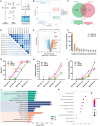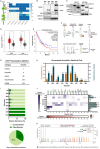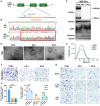Proteomic Analysis of Extracellular Vesicles Identifies CDCP1 as Critical Metastasis-Related Glycoprotein in Lung Cancer
- PMID: 40693605
- PMCID: PMC12281461
- DOI: 10.1002/jev2.70128
Proteomic Analysis of Extracellular Vesicles Identifies CDCP1 as Critical Metastasis-Related Glycoprotein in Lung Cancer
Abstract
Lung cancer is the most prevalent malignancy worldwide, with the majority of fatalities attributed to metastasis. Recent studies have demonstrated the pivotal role of extracellular vesicles (EVs) and glycoproteins in tumor progression. In this study, we compared the glycoproteome of EVs from 95C (low metastatic) and 95D (high metastatic) lung cancer cells to discover key targets in metastasis. Through coupling lectin affinity chromatography with quantitative proteomics, 1562 glycoproteins were identified. Compared to 95C EVs, 23 glycoproteins were significantly upregulated more than 20-fold in 95D EVs, including CDCP1, TNC, NCAM2, and ITGA4. CUB-domain containing protein 1 (CDCP1) was upregulated 143-fold in 95D EVs, which is significantly correlated with poor prognosis of lung cancer patients in the TCGA database. We subsequently performed site-specific glycoform profiling of CDCP1 using intact glycopeptide enrichment. Then we generated CDCP1 knockout (KO) 95D cell lines and revealed that the absence of CDCP1 reduced cell migration ability, which was also confirmed by EVs and cell co-culture experiments. We further performed Ti4+-IMAC-based phosphoproteomic analysis to investigate the changes in signaling pathways in CDCP1 KO cell lines. 147 differentially expressed phosphoproteins were revealed. Verification experiments confirmed that the levels of phosphorylated SRC and JUN proteins, markers of ErbB signaling pathway, were decreased 5.5-fold and 4.2-fold, respectively. Glycosylation site mutagenesis identified N339 and N386 as critical functional determinants of CDCP1. Collectively, our data demonstrate that glycoprotein CDCP1 was selectively packed into EVs and potentially contributed to cancer metastasis, which is a critical target for anti-metastasis research and cancer therapy.
Keywords: CDCP1; extracellular vesicles; glycoproteomics; lung cancer; metastasis.
© 2025 The Author(s). Journal of Extracellular Vesicles published by Wiley Periodicals LLC on behalf of International Society for Extracellular Vesicles.
Conflict of interest statement
The authors declare no conflicts of interest.
Figures








Similar articles
-
4-plex quantitative glycoproteomics using glycan/protein-stable isotope labeling in cell culture.J Proteomics. 2025 Jan 6;310:105333. doi: 10.1016/j.jprot.2024.105333. Epub 2024 Oct 18. J Proteomics. 2025. PMID: 39426592
-
The RNA binding protein IGF2BP2/IMP2 alters the cargo of cancer cell-derived extracellular vesicles supporting tumor-associated macrophages.Cell Commun Signal. 2024 Jun 27;22(1):344. doi: 10.1186/s12964-024-01701-y. Cell Commun Signal. 2024. PMID: 38937789 Free PMC article.
-
Proteomic profiling and functional characterization of serum-derived extracellular vesicles in the mucinous and non-mucinous colon adenocarcinoma.J Cancer Res Clin Oncol. 2023 Sep;149(11):9285-9300. doi: 10.1007/s00432-023-04851-7. Epub 2023 May 19. J Cancer Res Clin Oncol. 2023. PMID: 37204515 Free PMC article.
-
Systemic treatments for metastatic cutaneous melanoma.Cochrane Database Syst Rev. 2018 Feb 6;2(2):CD011123. doi: 10.1002/14651858.CD011123.pub2. Cochrane Database Syst Rev. 2018. PMID: 29405038 Free PMC article.
-
A rapid and systematic review of the clinical effectiveness and cost-effectiveness of paclitaxel, docetaxel, gemcitabine and vinorelbine in non-small-cell lung cancer.Health Technol Assess. 2001;5(32):1-195. doi: 10.3310/hta5320. Health Technol Assess. 2001. PMID: 12065068
References
-
- Attwood, M. M. , Fabbro D., Sokolov A. V., Knapp S., and Schiöth H. B.. 2021. “Trends in Kinase Drug Discovery: Targets, Indications and Inhibitor Design.” Nature Reviews. Drug discovery 20, no. 11: 839–861. - PubMed
-
- Bagdonaite, I. , Malaker S. A., Polasky D. A., et al. 2022. “Glycoproteomics.” Nature Reviews Methods Primers 2, no. 1: 48.
-
- Bilbrough, T. , Piemontese E., and Seitz O.. 2022. “Dissecting the Role of Protein Phosphorylation: A Chemical Biology Toolbox.” Chemical Society Reviews 51, no. 13: 5691–5730. - PubMed
MeSH terms
Substances
Grants and funding
- No. 21675110/National Natural Science Foundation of China
- No. 22374098/National Natural Science Foundation of China
- No. 19ZR1427800/Natural Science Foundation of Shanghai Municipality
- No. 21ZR1433200/Natural Science Foundation of Shanghai Municipality
- No. 23ZR1434200/Natural Science Foundation of Shanghai Municipality
LinkOut - more resources
Full Text Sources
Medical
Research Materials
Miscellaneous

